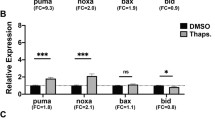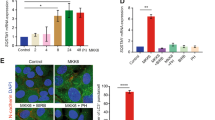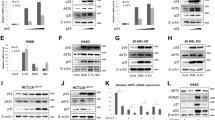Abstract
The serine/threonine protein kinase, Akt/PKB, has an essential function in cell survival during response to various stresses. Recent studies have demonstrated that Akt isoforms exhibit some distinct physiological functions, but the isotype-specific functions for Akt in the stress response have not been fully identified. In this study, we analysed the cellular response to genotoxic stress using isogenic wild-type, Akt1−/− and Akt2−/− mouse embryonic fibroblasts (MEFs). Marked hypersensitivity of Akt2−/− MEFs was observed to UV irradiation, whereas wild-type and Akt1−/− MEFs showed comparable levels of resistance. Akt2−/− mouse aortic endothelial cells also showed hypersensitivity to UV and the reconstitution of Akt2 expression in the Akt2−/− MEFs restored the UV resistance of the cells. Interestingly, upon UV irradiation, JNK and p38 were significantly upregulated in Akt2−/− MEFs, compared to wild-type and Akt1−/− MEFs. Additionally, inhibition of JNK and p38 activation reduced UV-induced cell death. Furthermore, both the hyperactivation of JNK and p38 and the UV-induced cell death in Akt2−/− MEFs were completely inhibited by restoring Akt2 expression. These results indicate that Akt2, but not Akt1, is essential for cell survival upon UV irradiation, and that Akt2 prevents UV-induced cell death by inhibiting activation of JNK and p38.
This is a preview of subscription content, access via your institution
Access options
Subscribe to this journal
Receive 50 print issues and online access
$259.00 per year
only $5.18 per issue
Buy this article
- Purchase on Springer Link
- Instant access to full article PDF
Prices may be subject to local taxes which are calculated during checkout






Similar content being viewed by others
References
Alessi DR, Cohen P . (1998). Mechanism of activation and function of protein kinase B. Curr Opin Genet Dev 8: 55–62.
Bae SS, Cho H, Mu J, Birnbaum MJ . (2003). Isoform-specific regulation of insulin-dependent glucose uptake by Akt/protein kinase B. J Biol Chem 278: 49530–49536.
Brazil DP, Yang ZZ, Hemmings BA . (2004). Advances in protein kinase B signalling: AKTion on multiple fronts. Trends Biochem Sci 29: 233–242.
Chan TO, Rittenhouse SE, Tsichlis PN . (1999). AKT/PKB and other D3 phosphoinositide-regulated kinases: kinase activation by phosphoinositide-dependent phosphorylation. Annu Rev Biochem 68: 965–1014.
Cheng JQ, Lindsley CW, Cheng GZ, Yang H, Nicosia SV . (2005). The Akt/PKB pathway: molecular target for cancer drug discovery. Oncogene 24: 7482–7492.
Cho H, Mu J, Kim JK, Thorvaldsen JL, Chu Q, Crenshaw III EB et al. (2001a). Insulin resistance and a diabetes mellitus-like syndrome in mice lacking the protein kinase Akt2 (PKB beta). Science 292: 1728–1731.
Cho H, Thorvaldsen JL, Chu Q, Feng F, Birnbaum MJ . (2001b). Akt1/PKBalpha is required for normal growth but dispensable for maintenance of glucose homeostasis in mice. J Biol Chem 276: 38349–38352.
Coffer PJ, Jin J, Woodgett JR . (1998). Protein kinase B (c-Akt): a multifunctional mediator of phosphatidylinositol 3-kinase activation. Biochem J 335 (Part 1): 1–13.
Datta SR, Brunet A, Greenberg ME . (1999). Cellular survival: a play in three Akts. Genes Dev 13: 2905–2927.
Easton RM, Cho H, Roovers K, Shineman DW, Mizrahi M, Forman MS et al. (2005). Role for Akt3/protein kinase Bgamma in attainment of normal brain size. Mol Cell Biol 25: 1869–1878.
George S, Rochford JJ, Wolfrum C, Gray SL, Schinner S, Wilson JC et al. (2004). A family with severe insulin resistance and diabetes due to a mutation in AKT2. Science 304: 1325–1328.
Heron-Milhavet L, Franckhauser C, Rana V, Berthenet C, Fisher D, Hemmings BA et al. (2006). Only Akt1 is required for proliferation, while Akt2 promotes cell cycle exit through p21 binding. Mol Cell Biol 26: 8267–8280.
Ichijo H . (1999). From receptors to stress-activated MAP kinases. Oncogene 18: 6087–6093.
Kim AH, Khursigara G, Sun X, Franke TF, Chao MV . (2001). Akt phosphorylates and negatively regulates apoptosis signal-regulating kinase 1. Mol Cell Biol 21: 893–901.
Kim MA, Kim HJ, Brown AL, Lee MY, Bae YS, Park JI et al. (2007). Identification of novel substrates for human checkpoint kinase Chk1 and Chk2 through genome-wide screening using a consensus Chk phosphorylation motif. Exp Mol Med 39: 205–212.
Liao Y, Hung MC . (2003). Regulation of the activity of p38 mitogen-activated protein kinase by Akt in cancer and adenoviral protein E1A-mediated sensitization to apoptosis. Mol Cell Biol 23: 6836–6848.
Pekarsky Y, Koval A, Hallas C, Bichi R, Tresini M, Malstrom S et al. (2000). Tcl1 enhances Akt kinase activity and mediates its nuclear translocation. Proc Natl Acad Sci USA 97: 3028–3033.
Rane MJ, Coxon PY, Powell DW, Webster R, Klein JB, Pierce W et al. (2001). p38 Kinase-dependent MAPKAPK-2 activation functions as 3-phosphoinositide-dependent kinase-2 for Akt in human neutrophils. J Biol Chem 276: 3517–3523.
Ronai Z . (1999). Deciphering the mammalian stress response—a stressful task. Oncogene 18: 6084–6086.
Vivanco I, Sawyers CL . (2002). The phosphatidylinositol 3-kinase AKT pathway in human cancer. Nat Rev Cancer 2: 489–501.
Yuan ZQ, Feldman RI, Sun M, Olashaw NE, Coppola D, Sussman GE et al. (2002). Inhibition of JNK by cellular stress- and tumor necrosis factor alpha-induced AKT2 through activation of the NF kappa B pathway in human epithelial Cells. J Biol Chem 277: 29973–29982.
Yuan ZQ, Feldman RI, Sussman GE, Coppola D, Nicosia SV, Cheng JQ . (2003). AKT2 inhibition of cisplatin-induced JNK/p38 and Bax activation by phosphorylation of ASK1: implication of AKT2 in chemoresistance. J Biol Chem 278: 23432–23440.
Yun J, Zhong Q, Kwak JY, Lee WH . (2005). Hypersensitivity of Brca1-deficient MEF to the DNA interstrand crosslinking agent mitomycin C is associated with defect in homologous recombination repair and aberrant S-phase arrest. Oncogene 24: 4009–4016.
Yun SJ, Kim EK, Tucker DF, Kim CD, Birnbaum MJ, Bae SS . (2008). Isoform-specific regulation of adipocyte differentiation by Akt/protein kinase Balpha. Biochem Biophys Res Commun 371: 138–143.
Acknowledgements
This work was supported by a grant of the National R&D Program for Cancer Control, Ministry of Health & Welfare, Republic of Korea (0620060-2) and Research Program of dual regulation mechanisms of aging and cancer from KOSEF (Korea Science and Engineering Foundation) (M1075604000107N560400110).
Author information
Authors and Affiliations
Corresponding author
Rights and permissions
About this article
Cite this article
Kim, MA., Kim, HJ., Jee, H. et al. Akt2, but not Akt1, is required for cell survival by inhibiting activation of JNK and p38 after UV irradiation. Oncogene 28, 1241–1247 (2009). https://doi.org/10.1038/onc.2008.487
Received:
Revised:
Accepted:
Published:
Issue Date:
DOI: https://doi.org/10.1038/onc.2008.487
Keywords
This article is cited by
-
MicroRNA-184 inhibits neuroblastoma cell survival through targeting the serine/threonine kinase AKT2
Molecular Cancer (2010)
-
The ILK/PINCH/parvin complex: the kinase is dead, long live the pseudokinase!
The EMBO Journal (2010)



